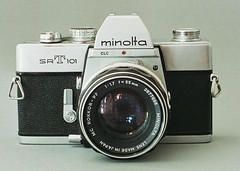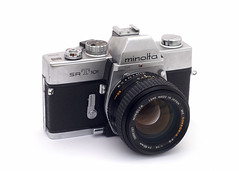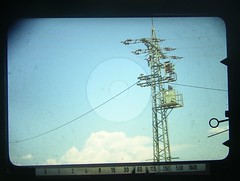Difference between revisions of "Minolta SR-T 101"
m (links, very minor grammar) |
m (link) |
||
| Line 38: | Line 38: | ||
* The manual-focus [[Rokkor]] lenses have a very good reputation and some are very fast: the fastest standard lens is 50mm f/1.2. | * The manual-focus [[Rokkor]] lenses have a very good reputation and some are very fast: the fastest standard lens is 50mm f/1.2. | ||
| − | * The SR-T 101 uses a PX625 cell for the metering system only. With a dead battery, all functions but the meter will continue to work. | + | * The SR-T 101 uses a [[PX625]] cell for the metering system only. With a dead battery, all functions but the meter will continue to work. |
== Links == | == Links == | ||
Revision as of 23:17, 11 September 2008
Contents
Introduction
The Minolta SR-T 101 is a 35mm SLR camera made by Minolta from 1966 through 1981. Users often refer to it as "the tank". It's a heavy, robust and reliable camera, capable of producing great results even 40 years after its introduction. It has a number of features that could be considered advanced in its day.
Metering: CLC and full aperture TTL
Camera ads from the 1970s boast of its CLC (Contrast Light Metering), calling it "the brain". CLC is a form of TTL metering with two CdS cells. It compensates for over-exposure by assuming that the upper side of the picture is the sky (overcast) and that the lower part is the subject you want to photograph. ISO values can be set from 6 to 6400.
| viewfinder |
|---|
|
The SR-T 101's viewfinder shows the exposure meter's needle at the right side of the finder image. The circle on the second visible needle shows the light value needed for the actual shutter-speed/aperture selection. When these pre-selections are corrected manually this 2nd needle moves towards the meter's needle. The second image shows the meter in battery control mode: needle over the little rectangle means correct voltage. |
Correct exposure is achieved by matching a needle in the viewfinder to a circle moving with the exposure settings. Strangely though, the needle moves down when light increases.
The Minolta SR-T 101 was one of the first cameras to have full aperture TTL metering. This was possible thanks to the fact that Minolta had placed the aperture ring on its Rokkor MC lenses close to the camera body. This way, the position of the aperture ring could be communicated mechanically to the metering system inside the camera. What is actually transmitted is not the aperture itself, but the offset between the selected aperture and the lens' maximal aperture.
Other specifications
- The SR-T 101 has a cloth focal plane shutter with speeds from 1 sec to 1/1000. The film advance lever automatically cocks the shutter, preventing double exposures. Shutter speeds are shown at the bottom of the viewfinder.
- It has some interesting features which set it apart from many other SLRs of that time, like mirror lockup, a mechanical self-timer and a depth-of-field preview button.
- The manual-focus Rokkor lenses have a very good reputation and some are very fast: the fastest standard lens is 50mm f/1.2.
- The SR-T 101 uses a PX625 cell for the metering system only. With a dead battery, all functions but the meter will continue to work.
Links
- Minolta SR-T series; an overview of features.
- Review at Classic Cameras
- Rokkor files
- SR-T 101 Manual (JPEG Scans)
- SR-T 101 versions and comparison with contemporary SLRs
- SRT-101 at www.collection-appareils.fr
- French User manual at www.collection-appareils.com
- Service manual at www.collection-appareils.fr
Photobloggers Using the SR-T 101
| Minolta Classic Cameras |
|---|
| Vest (or Best) | V2 | SR-2 | SRT 101 | XE | XD | CLE | 7000 | 9000 | 800 si |



